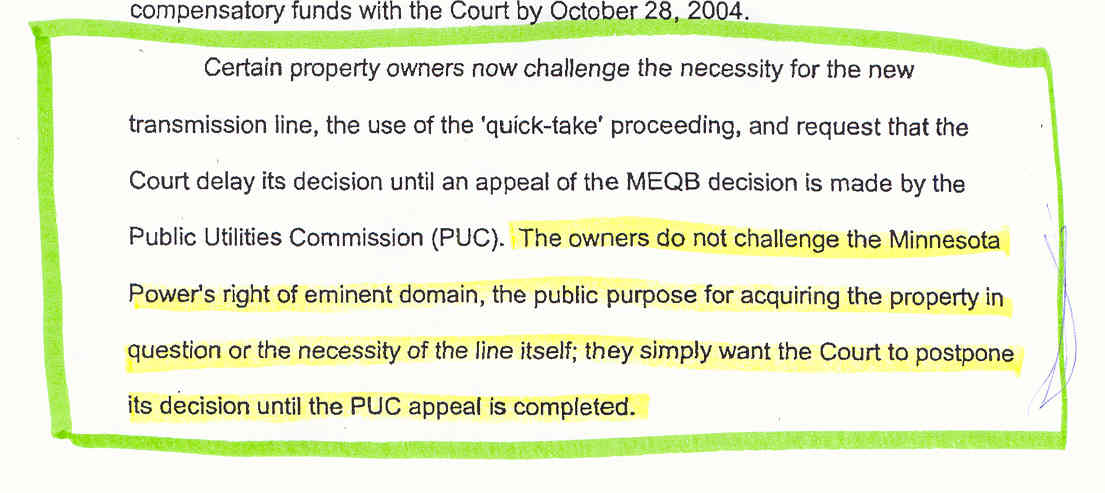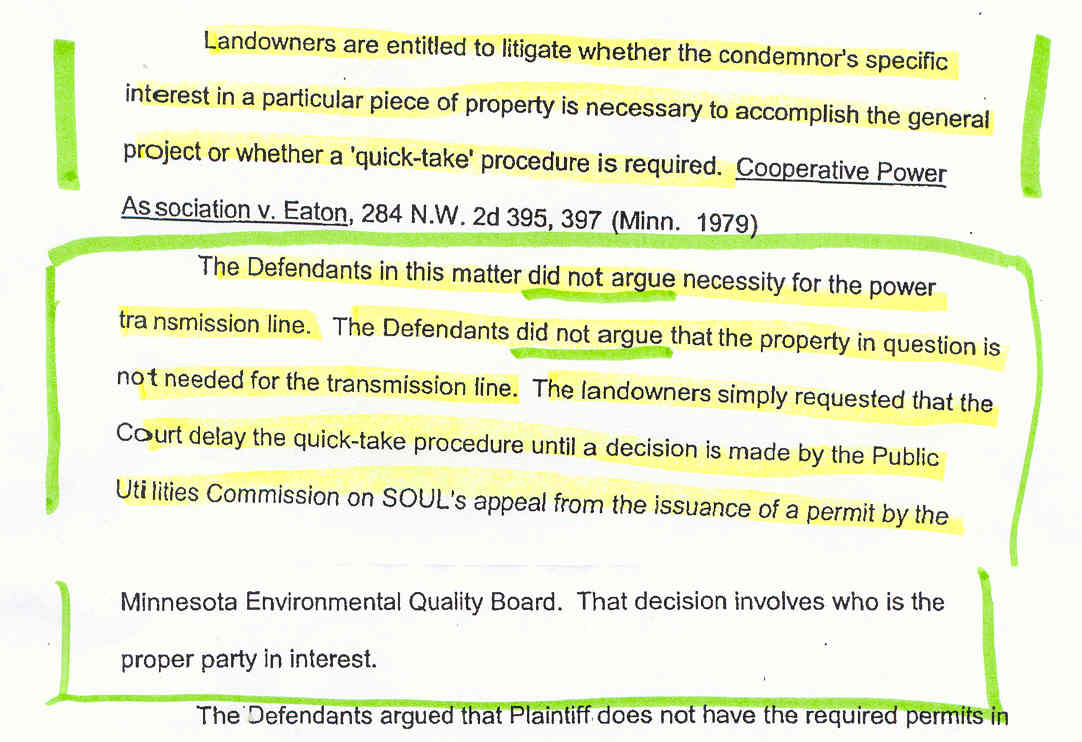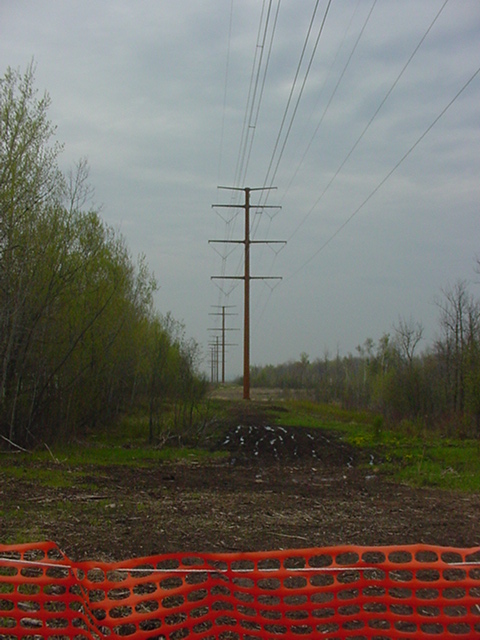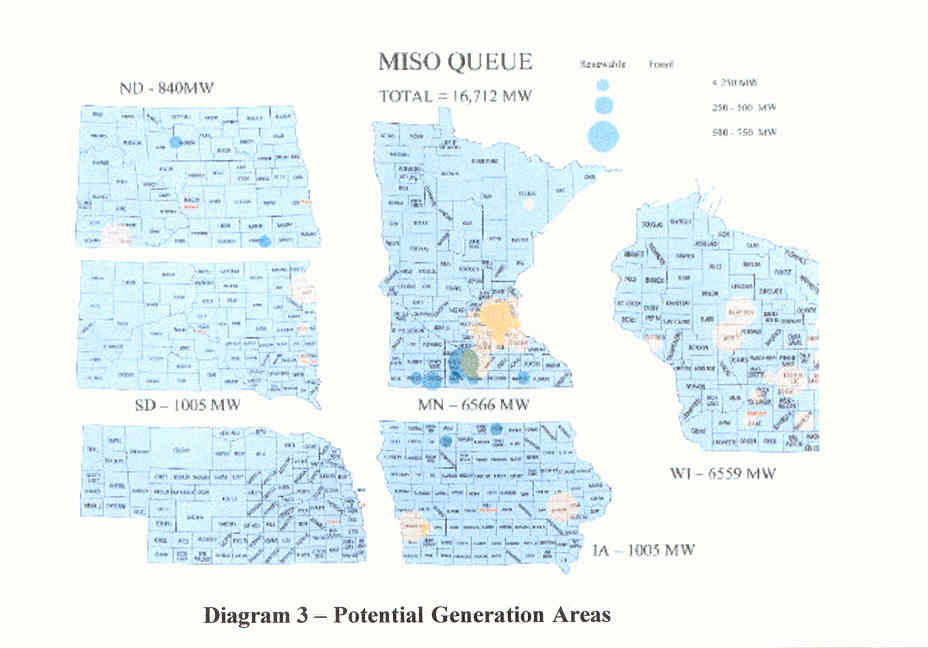I-35 – We need the cost information NOW!
July 14th, 2005
Last night was the I-35 Committee 1 meeting. Lesson learned:
WE NEED THE COST INFORMATION NOW!
What will it cost to upgrade this Co. Rd. 1 and Co. Rd. 46 intersection to handle the ultimate planned buildout, which, with area growth projected in the county transportation plan, goes from 400 trips/day to 9,270 trips/day east west on Co. Rd. 1, and from 160 trips/day to 4,400 trips/day north south on Co. Rd. 46. What will it cost to tear down the Co. Rd. 1 bridge and rebuild it to 4 lane or wider with turn lanes? Who is going to pay?
The committee was presented with the traffic information yesterday, and Leif Knecht is considering the costs of infrastructure for the I-35 development, and he’s on to something here. He started out on infrastructure costs clarifying that though we know it’ll only be an estimate, a range to expect, we need to know how much it will cost. He also said that we should be aware of what the costs would be NOT to develop the area.
Transportation infrastructure, there are huge costs, and the impact of development will be felt 10 miles in each direction for the anticipated 11 million square feet, so we should expect infrastructure costs in the ballpark of $70-100 million. We need this information, we need to understand up front what we?re buying into, and to know that there aer reverberations in terms of costs. In addition to the specific infrastructure costs, part of that is environmental and lifestyle issues too, there will be increased traffic, increased crime. When are we going to address those larger concerns?
The consultant’s answer to this question was not encouraging. He said that this would be addressed primarily in mitigation, after sending it out to the agencies.
My question: If it happens only AFTER it is sent to the agencies, how will agencies be able to review for reasonableness and feasibility and completeness and accuracy and whateve else the agencies will check? How will citizens be able to comment on it if that information is not available until the mitigation phase? The mitigation phase is AFTER the public comment period, it is the phase where public comments are addressed. THIS IS A PROBLEM.
Leif’s response to their timing suggestion?
We may find that the cost analysis says this is a good investment, this is a good move, but until we have the cost analysis, I?m a little nervous.
Tom McMahon, Dundas engineer, was also questioning the plan of doing the infrastructure in the order planned, that if Phase I businesses go up around the Co. Rd. 1 and Co. Rd. 46 intersection, and then after they’re built the Co. Rd. 1 Interstate 35 bridge comes down and is rebuilt, those business will be without access.
Are the consultants paying attention?
The good news is that it seems the original timeline, which anticipated the AUAR would be distributed to state agencies in July, well, it is not going to happen. That is good, and I expect, not hope, EXPECT, that the information needs identified by the group will be incorporated in.
LET’S SEE THOSE COST ESTIMATES, AND LET’S SEE THEM SOON!
At long last, former Rep. Loren Jennings goes to trial!
July 11th, 2005
Former Rep. on trial in alleged fraud, conspiracy
Former state Rep. Loren Jennings is set to go on trial Tuesday on charges he used his office to funnel money into a company in which he had invested.
The trial will take place in federal court in St. Paul.
Jennings, 54, was indicted in October and charged with four counts of mail fraud, one count of conspiracy and two counts of money laundering.
The DFLer from Harris served in the House of Representatives from 1985 to 2002. That included a stint as chairman of the House Regulated Industries Committee, which dealt with utilities.
The charges say Jennings solicited over $650,000 in payments from power companies to Northern Pole, Inc.
Jennings’ attorney said his client denies the charges and looks forward to his day in court.
————————————————
And a longer one in the Brainerd Dispatch:
Jennings: Former state lawmaker set to stand trial. (Brainerd-AP)
And another from when he was indicted:
Former state legislator Loren Jennings of Harris indicted on federal charges of mail fraud, money laundering
Arrowhead Eminent Domain — Transmission Happens!
July 11th, 2005
Eminent Domain has been in the news thanks to the Supremes decision in Kelo, et al. v. City of New London. Compare that with the Minnesota Supreme Court’s Walser case, about public purpose. Now I’m not done wading through Kelo yet, but it seems to me that Kelo plays out no differently than eminent domain as currently operating in Minnesota, that where there’s an umbrella of a deliberate plan by a governmental unit that is “essentially” public purpose, distinct from public use, they can take land and hand it over to a private developer for a private use. The burden is on those whose land is being condemned to prove up an illegitimate purpose, or that it benefits “a particular class of identifiable individuals” (like Mesaba’s Tom Micheletti and wife??).
The only defining clue I see in the decision is the court’s emphasis on this quote from Hawaii Housing Authority v. Midkiff, 467 U.S. 229, 242 (1984):
When the legislature’s purpose is legitimate and its means are not irrational, our cases make clear that empirical debates over the wisdom of takings — no less than debates over the wisdom of other knds of socioeconomic legislation — are not to be carried out in the federal courts.
So in a case, oh, … say, like Mesaba, where it’s an illegitimate purpose and the means are irrational, sounds like the door is wide open!
Another important decision in Minnesota is the Siegel case, holding that Plaintiffs had a valid claim (which they’d have to prove up) and could proceed and enter their evidence that governmental actions that diminished the value and limited their use of their property constitutes a taking:
Although the pleadings state no claim of total worthlessness, the pleadings permit proof that the city’s and the MCDA’s actions left appellants without economically viable rental and development uses for their property and, therefore, that appellants have a right to recovery under the Takings Clause.

On the subject of eminent domain, this last week, I got a big box of exhibits from Minnesota Power. It’s the documentation requested in the Arrowhead PUC case where Minnesota Power wants to transfer ownership to ATC, and a large part of it was the easement agreements and the Condemnation Orders. It was the Condemnation Orders that were hard to take, because they revealed that the landowners did not avail themselves of the challenges open to them.
There are only a few valid challenges to a condemnation proceeding, which is governed by Minn. Stat. ch. 117, and they focus on the authority of the party taking, and a very narrow look at the “need” and public purpose for the taking. A Certificate of Need is per se “need” for the line, but there was no Certificate of Need for the Arrowhead line because the line fell just under the threshold where one is required. As a part of the EQB proceeding, Intervenors tried to raise the need issue, but after the Chisago project, the EQB stayed far away. There has been no governmental need determination in Minnesota for the Arrowhead Transmission Line. “Need” for the line is in question.
In this case, there was another opening for review, a constitutional challenge that landowners did not receive notice that the Arrowhead Exemption from the Power Plant Siting Act would eliminate their rights under the “Buy the Farm” provision — that because the landowners were not notified of the meaning and effect of the exemption, their waiver of participation was not valid. I’d raised this at the Appellate Court in the Arrowhead appeal, C4-01-1022, and had submitted the transcripts to show this WAS raised before the Board! None of the landowners knew about “Buy the Farm” or that if the project were exempted, “Buy the Farm” would not apply. But during the oral argument, the panel noted a couple of times that this argument had to be raised in the condemnation court.
As we can see in the eminent domain cases above, constructive takings happen when insufficient notice is given and when property value and land rights disappear when governments take action, a need determination must be made and there must be a public purpose for the taking, and landowners must receive proper notice of their rights and whether rights may be lost as a consequence of governmental action. None of these legitimate challenges to condemnation were made in the Arrowhead condemnation proceedings. Instead, the court notes that those defending against condemnation just wanted the condemnation decision delayed until PUC decided on the NAWO and SOUL Complaint to revoke the EQB’s exemption.
Here’s what the court thought of that — the incredulous “look over the top of its glasses” is audible — below is an example of the Arrowhead Orders, one of many, but they’re all identical, it’s broken down into Parts I and II because it’s “too large” to upload, and Part II Memo is the one with the court’s reasoning:
Part I Download filePart II Memo Download file
Here’s the short version of what the District Court said:



NAWO and SOUL filed a Complaint with the PUC to revoke the EQB’s exemption — asked one agency to overturn the decision of another! Here’s a copy of the PUC Order dismissing that Complaint and telling NAWO and SOUL to bring the request to revoke the EQB decision to the EQB.
They Arrowhead landowners were at the horse track, but ignored the ponies and bet all they had on a rescue greyhound that wasn’t even in the gate! The quick-take condemnation goes forward.
Sigh… Transmission happens!

Calling all St. Lawrence Band members !!!
July 10th, 2005
The St.LB Reunion is getting closer, and if you were a member and haven’t heard about the reunion yet, contact Dave Lucking (info below) and WRITE THIS DOWN:
Saturday, August 27, 20051:00-6:00 p.m. – and continuing…
St. Lawrence Church
1203 – 5th Street S.E.
Minneapolis, MN 55414
Here’s a map and directions.For more information, contact:
Cookie Ostrom (507) 232-4272 tcookieb7@yahoo.com
Dave Lucking (612) 781-1159 lealip@aol.com
They’re starting to come out of the woodwork — this week I’ve heard from a bunch of people who were in the band a generation or two before me. And more than a few “Is that YOU?” like the blast out of nordeast from Jan Shupien and then from Kris Fix, they were former roommates at the “Como Zoo;” and I found Susan Gecas (Koob) at the GunFlint Tavern in Grand Marais; her sister Sandra Koob who runs C&S Horse Boarding in Brooksville, Florida; Randy Ottoson was the first to pass on the info on this, he’s now a nurse for Hennepin County; PJ Belvedere, brother of my friend Jo Belvedere who is doing strange things with Mississippi River Mollusks (couldn’t find anything on PJ, but they call his father Paul “one of the fathers of posterior composites!); we sure can’t forget Kelly Doran for U.S. Senate, and of course my little bro’ David Overland now at the Islander RV Resort in Lake Havasu, AZ! And the computer lit up with missives from my brother-in-law Paul McGovern, out in Washington state, who’s about to have his third kid and just got laid off after 15 years (openings in photographic engineering, leave a comment here!), and Peggy McGovern, whose husband just retired from the Navy, and are now first time homeowners up in Forest Lake, closer to family, well, anywhere in the country would be near one sibling or another, closer to more of her family.
St. Lawrence Band alumni — check in!
For more information about the St.LB reunion, contact:
Cookie Ostrom (507) 232-4272 tcookieb7@yahoo.com
Dave Lucking (612) 781-1159 lealip@aol.com
GENERATION FOR VOLT-DOLTS #1 (WHO CAN’T ACCEPT EVIDENCE EVEN WHEN IT’S SMACKING ‘EM UPSIDE DA HEAD!)
July 9th, 2005
Today another industry report came over the wire, not “Generation According to Overland,” but the Mid-Continent Area Power Pool list of generation projects. Remember that we “needed” 6,000MW of generation, and the MISO queue has 16,712MW in line for interconnection? Here’s that MISO map again, p. 7 of CapX2020, 16,712MW:

Now, here’s the MAPP generation “Form 3” that reports generation, and note that the 600MW of Big Stone and 500MW of Coal Creek is not included, so add that to the 11,174, and I don’t see ANYTHING listed for western Wisconsin either, and there is generation going up. We’re right on track! Here’s that MAPP Form 3 : Download file

Later today, I’ll add in the MAPP 2004 Load and Capability Report pages for Xcel, but that will take a while to separate the relevant charts out of 487 pages! I’m in the process of comparing what Load and Capability details Xcel produced for the PUC Monticello Dry Cask Storage docket. I’d requested an Order that Xcel produce that and cost/benefit information and got the Order (see 2,3,4), but from the looks of it, the Xcel information that it claims to have taken from its Integrated Resource Plan is different from the MAPP information that Xcel provided MAPP, so I’ve got to figure out what the difference is and how to get the info I need. What fun!